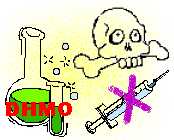
Dihydrogen Monoxide (DHMO) is a colorless and odorless chemical compound, also referred to by some as Dihydrogen Oxide, Hydrogen Hydroxide, Hydronium Hydroxide, or simply Hydric acid. Its basis is the unstable radical Hydroxide, the components of which are found in a number of caustic, explosive and poisonous compounds such as Sulfuric Acid, Nitroglycerine and Ethyl Alcohol.
Although the U.S. Government and the Centers for Disease Control (CDC) do not classify Dihydrogen Monoxide as a toxic or carcinogenic substance (as it does with better known chemicals such as hydrochloric acid and benzene), DHMO is a constituent of many known toxic substances, diseases and disease-causing agents, environmental hazards and can even be lethal to humans in quantities as small as a thimbleful.

Research conducted by award-winning U.S. scientist Nathan Zohner concluded that roughly 86 percent of the population supports a ban on dihydrogen monoxide. Although his results are preliminary, Zohner believes people need to pay closer attention to the information presented to them regarding Dihydrogen Monoxide. He adds that if more people knew the truth about DHMO then studies like the one he conducted would not be necessary.
A similar study conducted by U.S. researchers Patrick K. McCluskey and Matthew Kulick also found that nearly 90 percent of the citizens participating in their study were willing to sign a petition to support an outright ban on the use of Dihydrogen Monoxide in the United States.
Each year, Dihydrogen Monoxide is a known causative component in many thousands of deaths and is a major contributor to millions upon millions of dollars in damage to property and the environment. Some of the known perils of Dihydrogen Monoxide are:
| |
|
Despite the known dangers of DHMO, it continues to be used daily by industry, government, and even in private homes across the U.S. and worldwide. Some of the well-known uses of Dihydrogen Monoxide are:

- as an industrial solvent and coolant,
- in nuclear power plants,
- by the U.S. Navy in the propulsion systems of some older vessels,
- by elite athletes to improve performance,
- in the production of Styrofoam,
- in biological and chemical weapons manufacture,
- as a spray-on fire suppressant and retardant,
- in abortion clinics,
- as a major ingredient in many home-brewed bombs,
- as a byproduct of hydrocarbon combustion in furnaces and air conditioning compressor operation,
- in cult rituals,
- by the Church of Scientology on their members and their members' families,
- by both the KKK and the NAACP during rallies and marches,
- by pedophiles and pornographers (for uses we'd rather not say here),
- by the clientele at a number of homosexual bath houses in New York City and San Francisco,
- historically, in Hitler's death camps in Nazi Germany, and in prisons in Turkey, Serbia, Croatia, Libya, Iraq and Iran,
- in World War II prison camps in Japan, and in prisons in China, for various forms of torture,
- by the Serbian military as authorized by Slobodan Milosevic in their ethnic cleansing campaign,
- by many terrorist organizations,
- in community swimming pools to maintain chemical balance,
- in animal research laboratories, and
- in pesticide production and distribution.
|  |
One of the most surprising facts recently revealed about Dihydrogen Monoxide contamination is in its use as a food and produce "decontaminant." Studies have shown that even after careful washing, food and produce that has been contaminated by DHMO remains tainted by DHMO.
Our children are in peril, and we must act now! Contact your Senators and Representatives! Contact the EPA and FDA! Contact the Sierra Club, Earth First, and Al Gore! Let them know that we must end this assault on our health and our environment today! Before it is too late.


No comments:
Post a Comment